Hoogeveen
Hoogeveen [ˌɦoːɣəˈveːn] (![]() listen) (Dutch Low Saxon: 't Ogeveine or 't Oveine) is a municipality and a town in the northeastern Netherlands.
listen) (Dutch Low Saxon: 't Ogeveine or 't Oveine) is a municipality and a town in the northeastern Netherlands.

Hoogeveen | |
|---|---|
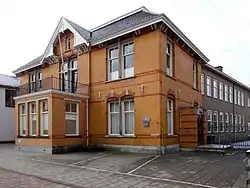 Former court house in Hoogeveen | |
 Flag Coat of arms | |
.svg.png.webp) Location in Drenthe | |
| Coordinates: 52°44′N 6°29′E | |
| Country | Netherlands |
| Province | Drenthe |
| Government | |
| • Body | Municipal council |
| • Mayor | Karel Loohuis (PvdA) |
| Area | |
| • Total | 129.25 km2 (49.90 sq mi) |
| • Land | 127.54 km2 (49.24 sq mi) |
| • Water | 1.71 km2 (0.66 sq mi) |
| Elevation | 12 m (39 ft) |
| Population (January 2019)[4] | |
| • Total | 55,662 |
| • Density | 436/km2 (1,130/sq mi) |
| Demonym(s) | Hoogevener |
| Time zone | UTC+1 (CET) |
| • Summer (DST) | UTC+2 (CEST) |
| Postcode | Parts of 7900 range |
| Area code | 0524, 0528 |
| Website | www |
Population centres
Elim, Fluitenberg, Hoogeveen and Noordscheschut, which still have the canals which used to be throughout the town. Other villages of the town are Hollandscheveld, Nieuw Moscou, Nieuweroord, Nieuwlande, Pesse, Stuifzand and Tiendeveen.
Hoogeveen
Hoogeveen dates its history to 20 December 1625, when Roelof van Echten bought a large tract of peat land from farmers of the district with the plan to harvest its peat. One old map of the area called it Locus Deserta Atque ob Multos Paludes Invia, a deserted and impenetrable place of many swamps. Hoogeveen itself was established in 1636 by Peter Joostens Warmont and Johan van der Meer.
Its coat of arms, granted 10 November 1819, is white, with a pile of peat covered in straw in the center and beehives on each side, representing the town's first two major industries.
Vincent van Gogh visited the area in the fall of 1883.[5]
In the second half of the 1960s, Hoogeveen was the fastest growing town in the Netherlands. Its rapid growth during that period led its city council to fill in most of the town's canals, canals dug in the area's early days when it was a prime source of peat.
Access to the town is provided by the A28 (Utrecht - Groningen) highway, the N/A37 (Hoogeveen - Germany), and the Western Cities - Groningen railway.
The then recognized oldest person in the world, Hendrikje van Andel-Schipper, lived in Hoogeveen until her death in August 2005, two months after her 115th birthday.
Hoogeveen also has a small airport that attracts some tourism. Since 1997 the Hoogeveen Chess Tournament has been organized here.
Transport
Railway Station: Hoogeveen
Notable people
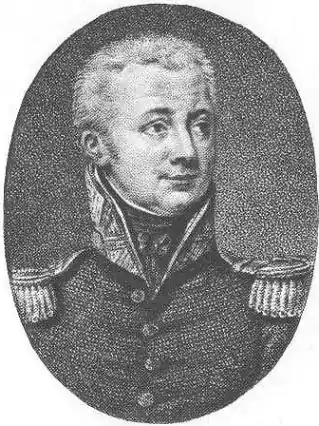
.jpg.webp)
- Leopold Karel, Count of Limburg Stirum (1758 in Hoogeveen - 1840) a politician, helped take power in 1813 to re-establish the monarchy
- Herman Bavinck (1854 in Hoogeveen – 1921) a Dutch Reformed theologian and churchman
- Hendrikje van Andel-Schipper (1890 – 2005 in Hoogeveen) the oldest person ever from the Netherlands
- Jan Bols (born 1944 in Hoogeveen) a former Dutch long track speed skater, participated in the 1968 and 1972 Summer Olympics
- Geert Booij (born 1947 in Hoogeveen) a Dutch linguist and academic, created construction morphology
- Jetta Klijnsma (born 1957 in Hoogeveen) Dutch politician
- Anne van Amstel (born 1974 in Hoogeveen) Dutch writer, psychologist and poet
- Lea Bouwmeester (born 1979 in Hoogeveen) a Dutch politician
- Jill de Jong (born 1982 in Hoogeveen) a Dutch model and actress[6]
Sport
- Piet Kleine (born 1951 in Hollandscheveld) a former speed skater, gold medallist at the 1976 Winter Olympics and silver medallist at the 1980 Winter Olympics
- Theo ten Caat (born 1964 in Hollandscheveld) a former Dutch professional footballer with 412 club caps
- Erik Dekker (born 1970) a retired Dutch professional road racing cyclist, medallist at the 1992 Summer Olympics
- Erik Bakker (born 1990 in Hoogeveen) a Dutch professional footballer with 320 club caps
- Vivianne Miedema (born 1996 in Hoogeveen) a Dutch professional footballer who has scored more goals at the international level for the Netherlands than any other player, across both the women's and men's teams and is the all-time leading scorer in the FA WSL.
Gallery
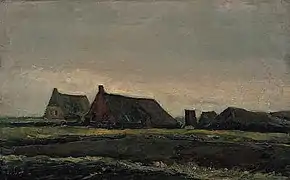 Huts in Zwartschaap, on the way between Hoogeveen and Pesse, painted by Van Gogh in 1883
Huts in Zwartschaap, on the way between Hoogeveen and Pesse, painted by Van Gogh in 1883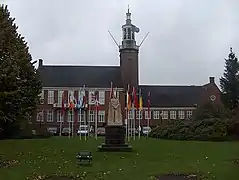 Town hall
Town hall.jpg.webp) Nieuwebrugsluis in Hoogeveen
Nieuwebrugsluis in Hoogeveen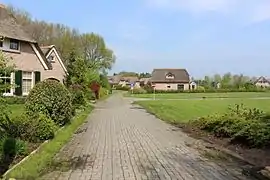 Villapark, Martensplek
Villapark, Martensplek
References
Footnotes
- "De leden van het college" [Members of the board of mayor and aldermen] (in Dutch). Gemeente Hoogeveen. Archived from the original on 5 January 2013. Retrieved 7 October 2013.
- "Kerncijfers wijken en buurten 2020" [Key figures for neighbourhoods 2020]. StatLine (in Dutch). CBS. 24 July 2020. Retrieved 19 September 2020.
- "Postcodetool for 7901BW". Actueel Hoogtebestand Nederland (in Dutch). Het Waterschapshuis. Archived from the original on 21 September 2013. Retrieved 7 October 2013.
- "Bevolkingsontwikkeling; regio per maand" [Population growth; regions per month]. CBS Statline (in Dutch). CBS. 1 January 2019. Retrieved 1 January 2019.
- Dead link to The New Yorker
- IMDb Database retrieved 07 September 2019
Bibliography
- Dijk, Wout J., & van der Sluis, Meent W.: De Drentse tijd van Vincent van Gogh, Boon uitgeverij, Groningen 2001 ISBN 90-75913-18-4
